#because they only really show or emphasize the violent or fatal parts
Note
What do you think of the fifth estate’s documentary on pit bulls?
I haven’t seen it fully, but honestly it comes off as fear-mongering.
Yes, pit bulls can do serious damage with their bite... any large dog can.
Yet the bans are only focused on pit bulls. What about german shepherds? or rottweilers? Chows?
It doesn’t help that the media and documentaries often use “pit bull” as an umbrella term to cover around 5 different breeds of dogs and upwards of 50% of dogs in shelters that get labeled as pit bulls are just lookalikes. Given that pit bull can refer to the American pit bull terrier, Staffordshire pit bull terrier, Staffordshire bull terrier, and American Bully.
Are we going to end up banning any dog that can fall underneath what just gets labeled as a pit bull? When they’re banned, what are we going to do next? Start banning the next highest breed of dogs that cause bites?
Not to mention, pit bulls, like any dog, need to be trained to not be aggressive, need to be properly socialized, etc. just like any other dog. Of course, it isn’t helped by the fact that the media (and documentaries like this) only care about when it is a pit bull.
Labs made up 13% of bites according to a 2008 study. pit bulls came in second at 8%. Yet people want to ban pit bulls but not labradors?
When it comes to personal injury claims of delivery workers, german shepherds, bull terriers, labs and border collies were among the most common to bite. Yet pit bulls are the only dangerous ones on the list?
And the documentary uses one man whose child was killed due to the babysitter leaving the child unattended with the dogs and that’s just like ??? that’s why you never leave children unattended with any dog that the dog is not familiar with.
Not to mention, BSL only focuses on pit bull and pit bull-type dogs, but what about german shepherds and labs who make up a significant portion of bite statistics? Small dogs like chihuahuas that can exhibit high amounts of aggression if not properly socialized?
ya know how many times I’ve had someone’s lab growl at me and snarled despite the owners saying they were friendly? A lot
The documentary even shows dogs that are chained up and acknowledges that one person sees many pit bulls living in puppy mills and backyard breeders who sell them as status, guard, or fighting dogs... And mind you, dogfighting is illegal because it is animal abuse but then contrasts that with a woman who worked in/with a shelter that basically tried to sell dogs that they knew may not be good fits for certain homes or families. So when you have ill-bred and ill-trained dogs by people somehow the solution is to ban the breed rather than coming down hard on irresponsible owners?
And yet it’s the breed's fault and the breed should be banned for shelters deciding to lie and be deceptive about how well a dog may fit within another family? So because a shelter, run by a group of people, decided to lie about a dog’s history or past... that means it is the dog's fault and they should be banned? What logic does it make to ban a dog or dog breed when shelters and people decide to intentionally be deceptive about it in order to just rehome them? You basically have someone in the documentary who admits to being irresponsible and negligent yet... ????
Like, this lady admitted to working in a shelter that would be deceptive about a dog’s temperament, but then went on to blame the breed.
It is only after someone dies or is bitten by a pit bull that people want to try to discuss BSL or banning them... but there was a woman, about 2 years ago, who got mauled by a pack of dachshunds yet there only concerns with pit bulls? people say one attack against people is too many yet... almost every dog breed in existence has attacked at least one person or animal. If you are banning breeds because they attack people, you’re going to be banning a lot more than pit bulls. If it is based on whether or not they are capable of killing someone, you’re going to be banning almost any medium to large size dog.
It’s almost no secret that toy breeds are known to be very aggressive due to the way they’re often treated and pampered... Chihuahuas rank fourth in breeds that have bitten children and even though their bites aren’t comparable to pit bulls or larger breeds, if the issue is the severity of the bite then... any large breed dog should be banned because any large dog can produce a severe or fatal bite.
Dogs are bred by people... if aggression is an issue, you can selectively breed that out the same way that certain dogs were selectively bred to be able to run or be as small as possible. If pit bulls get banned, what is going to be the next breed on the list? German Shepards? Dobermans? Chows?
Why are we coming down on breeds rather than irresponsible shelters that are deceptive about a dog’s temperament and backyard breeders that abuse and neglect dogs? Ofc when a dog comes from an abusive or neglectful situation, they’re going to have behavioral and temper issues... so that is somehow the fault of the breed itself?
The documentary ends by basically saying pit bulls are dangerous and it is a matter of public safety...By a surgeon that basically says no one will miss them after a while because there will be fewer fatalities even though other large dog breeds can cause fatalities, a woman who admitted to working for a shelter that would lie and intentionally be deceptive about a dog’s temperament in order to get them out the shelter, a father who lost his child and a baby sitter that was too irresponsible and let the child unattended with two large dogs who basically say “tell me which one is and isn’t going to attack” which can apply to literally any dog and then one pit bull lobbyist that they just portray as selfish and crazy.
Like if you show me two pictures of a chihuahua... I’m not going to know which is going to try to maul my hand. If you are banning pits, why not extend it to german shepherds, mastiffs, chows, etc.? They’re also large dogs that can cause fatal/severe bites. Why not ban chihuahuas, they’re the ones most likely to bite? is it only based on severity/fatality? If so then bye-bye to most large dog breeds.
Yeah totally not a biased documentary at all.
#rainbow answers#anon#ask#like fr its fear mongering vibes#like almost any other documentary on pit bulls#because they only really show or emphasize the violent or fatal parts#and focused exclusively on pit bulls but never brought in someone that had to get surgery#because they got attacked by say a lab chow or german shepard#it was pretty one sided and the comments showed how easily people give into fear mongering and information that says#a breed itself is dangerous and should be banned even though many other breeds#can have the same or similar issues as pit bulls#pit bulls and related breeds are not some vicious breed that is bloodthirsty and just waiting to be able to attack a human or animal#like i jest that chihuahuas are little demons in disguise but i don't genuinely believe that#yet when it comes to pit bulls and related breeds#everyone will believe the fear mongering and say they're just naturally or inherently dangerous#while ignoring the number of people that get bit by toy breeds or toy breeds that can be highly aggressive#like on what grounds are you using to ban dogs???#cause there are going to be a lot more banned than just pit bulls if you are in the favor of public interest and safety#Anonymous
115 notes
·
View notes
Text
No, RWBY is not Game of Thrones now
I just...
I can’t even...
How do you...
What the fuck?
Hhhhhhhmmmmmmm...
Okay,
Now in response to Clover’s death, I’ve seen some people claiming that because of this RWBY is now or is becoming Game of Thrones.
What.
Why? What is it that makes RWBY now GoT? The fact that a character died because that’s one of the things people remember Game of Thrones for? Hate to break it to ya, but this is not the first time a character has died, and for that matter RWBY still is restrained with character deaths, Clover being somewhere between the 10th-13th death of a named character, and on top of that most of the confirmed deaths in RWBY have happened near the end of a Volume, as does Clover’s, and the deaths that don’t occur near the end are typically minor characters only introduced just recently (Forest, that Hunter RNJR met in the village in Vol 4), compared to GoT, where at its height (seasons 2-5) characters would die at any point in a season, RWBY saves its important deaths for the end,
Do people think that this is bad writing like the final seasons of GoT? That Clover’s death was solely for shock value? I fail to see how it is, when something is done for shock value it is typically out of nowhere or something the audience could not see coming, done only for the purpose of shocking the audience, and so I ask, is it really “shocking” that a character who is a 5th member of a team (in a show that emphasizes teams of 4), who has a good luck based superpower-which is some major red flags, especially when you consider that despite Qrow having a bad luck power it has not yet proven fatal to himself, was stabbed in the back by a deranged serial killer?
Speaking of Tyrian, I think part of what made the kill so “shocking” is that in spite of all the hyping up he’s gotten, this is the first time Tyrian has killed a relevant character, especially when you compare him to our other violent, maniac, psychopath, Adam, who has been shown making a few kills (mostly of no-name goons, but also Sienna) and has permanently maimed one of the main characters, that and I think that a lot of people did not take Tyrian as seriously compared to Adam, as I said, they’re both violent psychotic, maniacs, but they’re madness is displayed differently, Adam’s is show through unfocused impotent rage and tantrums, whereas Tyrian’s is decidedly “goofy” (the guy took a minute during his escape to put a hat on), it may not be the intention, but this behavior coupled with a lack of clear body count/permanent impact on the main characters, could have caused viewers to not take him as seriously as they should have, forgetting that he is a deranged, fanatical serial killer, and what else would he do in a fight where he had an opening for a fatal blow?
Now some people might see the “team-up” between Qrow and Tyrian as “bad writing” or being out of character, and I supposed it would be... If it was a team-up
Other’s have pointed this out better than I will now, but Qrow hardly teams up with Tyrian, rather he keeps attacking him, but the issue is from Clover, who keeps going for Qrow instead of the on-the-loose serial killer, thus forcing Qrow not to fight with Tyrian, but to fight an enemy Tyrian is also fighting, and as can be seen in the fight, Tyrian is manipulating the fight by throwing/pushing Qrow into Clover
Speaking of, Clover acted completely in-character during all of this, nothing previously indicated that he would side against Ironwood, Clover has always followed his orders and never questioned them regardless of whether they’re right or how he may feel about them, that’s not what the ACE-OPs do, and he is the leader and best of them so why would he? Why would Ironwood choose someone who questions/goes against orders as leader his elite team when Ironwood has shown that he values loyalty and obedience? Clover arrested RWBYJNROQ for being hunters without licenses (even though the adult responsible for them did) when all they did was protect people from Grimm, and was completely silent and compliant with ideas such as arresting Robyn and declaring martial law, and in the case of fighting Qrow, he had orders to arrest him, Clover doesn’t question orders regardless of how he feels, and this was a new order compared to be ordered to apprehend Tyrian, who was already arrested when the fight began, and Tyrian had only really hurt Mantle, which Clover had been ordered to abandon so I doubt it really mattered to him whether Tyrian was caught compared to Qrow who could threaten Atlas (Ironwood), and as his Amity Arena card says his loyalty is to Atlas, and as is clear by Ironwood and his chosen elite Mantle ranges from an annoyance to not mattering to them
Lastly we have Queerbaiting and Bury Your Gays, and other’s explain it better and I’m tired so lets speedrun this:
Neither is the case
Y’all just convinced yourself that Clover was Gay and that Fairgame was the endgame
Queerbaiting is marketing/teasing LGBTQ+ content/characters then pulling the rug out and saying PSYCH! Clover was not marketed as LGBTQ+, you headcanoned him as such
Bury Your Gays is reducing/removing gay characters from a narrative, Clover is not confirmed to be Gay, Bi, etc, (yes, yes, I know some animators showed support for Fairgame, but animator’s do not determine the story) he certainly has a connection with Qrow but its not clear if its a friendship or a romantic one, it certainly could have grown to be romantic if given more time, but we’ll never know, and even if he was gay this would not be BYG because there are still plenty of LGBTQ+ characters and growing in RWBY, being gay does not give you invincibility, having a character be immune from harm because they’re gay is just as bad as killing off characters because they’re gay
On that note I’ll say this, even if they were romantic, or built-up to be, Clover still dies, because he still prioritizes following orders and ignored the psychopath he should have been fighting, sorry if I’m speaking ill of the dead here, but most of Clover’s death was his own fault
Here’s a little something about build-up, just because you have it doesn’t mean there will be pay-off, fiction has taught us that all build-up needs to have payoff, but that’s not how thing are, not everything gets a conclusion, romantic build-up can be cut short, people can die or lose interest in one another, maybe build-up with one person is a part of them realizing they’re interest in someone else, building-up to that
#rwby spoilers#rwby7 spoilers#rwby#rwby vol 7#game of thrones#fairgame#clover ebi#tyrian callows#qrow branwen#james ironwood#ace-ops#rwbyjnroq
133 notes
·
View notes
Note
Ugh you just reminded me how stupid it was that they had Tim narrating how he had more training and was smarter than him when Jason had more training than Tim. Honestly, I see a lot of fanon that tim admired Jason but from what i've seen canonically it seemed like he admired Dick and didn't have a high opinion of Jason but that was also due to the writer's view of Jason as well.
Oh I’m so gonna use that ask to do some more ranting against DC, thanks for that gratuitous occasion.
I think as Robin Tim did have some more training (what with Shiva etc, the writing insisted more on his formative days than with Dick or Jason) but saying, like was often the case, that Jason was thrown on the field before he was ready or that he was "the dumb brash Robin" is indeed part of the retcons that he suffered.


[Batman (1940) #411]
Jason was ready. Jason was an excellent Robin. And a very bright kid at that with an interest for detective work. None of that was ever put into question before Starlin waltzed in and casually retconned the character to fit his child-murder agenda. The mere idea that Bruce ‘I prepare for every contingency’ Wayne would’ve let an ill-prepared kid on the streets is one convenient overlook of his character.
Honestly out of all the legends that surround Tim, the one that has him idolizing Jason always confused me the most. Dick was indeed the one Tim idolized. And it’s not just that Tim didn’t admire Jason— he was more touched by the fact that Robin died, and he worried about the effect it had on Bruce. But Jason himself? Lmao no shit given. Tim only showed the slightest bit of respect for Jason once, in ‘Tec #618. Every other time he mentions Jason it’s more in that tone.
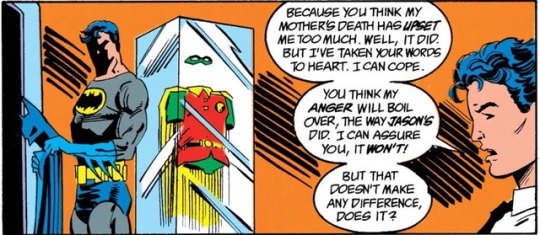
[Batman (1940) #455]
And there starts DC’s bullshit because not even considering that they conveniently kept Starlin’s "Jason’s default mode is anger", it’s Sheila who caused Jason’s death not his anger but look, looook how absolutely nothing is there to contradict Tim, if you read the full scene then not even Bruce tells him anything, no character ever puts Tim into question when he’s trashtalking Jason, Sheila will never ever be mentioned again in preboot and that’s not a frickin coincidence, I hate it
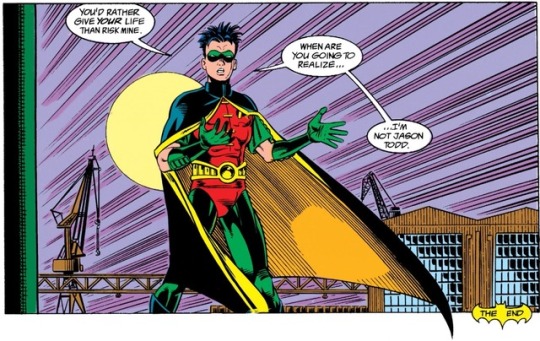
[Batman (1940) #469]
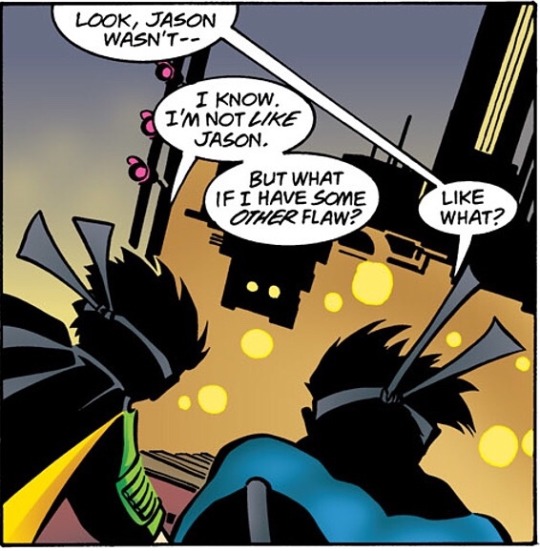
[Nightwing (1996) #25]
Even under Nicieza’s dodgy "partnership" the whole writing consists in making Jason incompetent af, insisting on how much Tim despises him, and emphasizing that he freed him of prison for Bruce & that he regrets it.

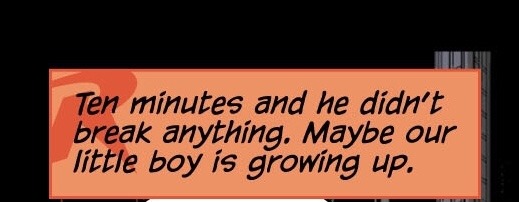
[Robin (1993) #183]
Part of Tim’s role as a character was to establish in the reader’s mind that he’s better than Jason, that Jason had some fatal flaw that caused his own death and wasn’t worthy for the Robin legacy (read: the child’s violent death is not DC’s or even Bruce’s fault) & that Tim wouldn’t repeat his mistakes. DC went as far as to instrumentalize other characters to drive that point through.
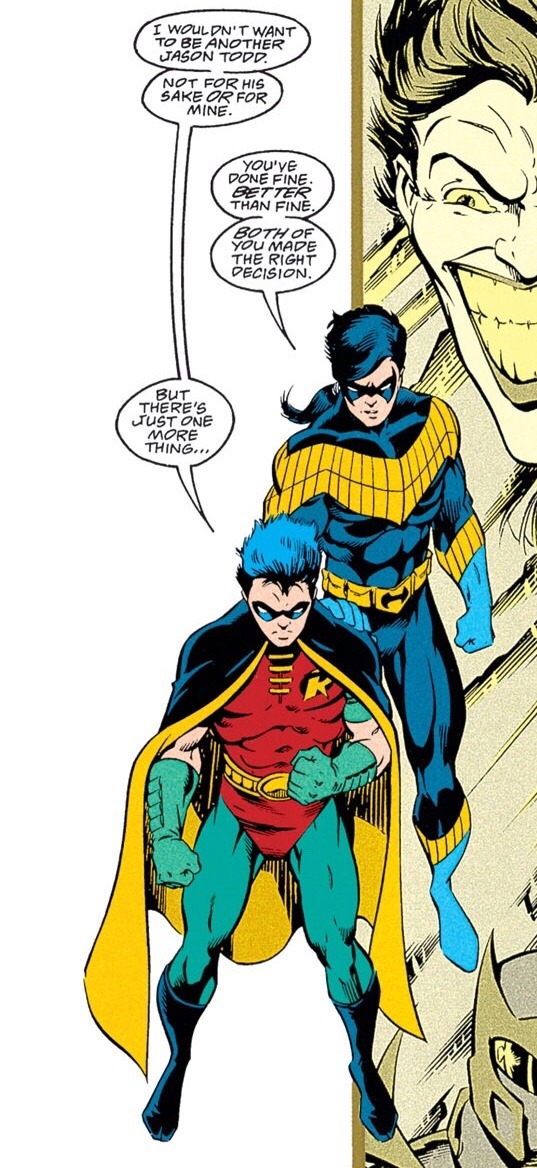
[Robin (1993) #0]
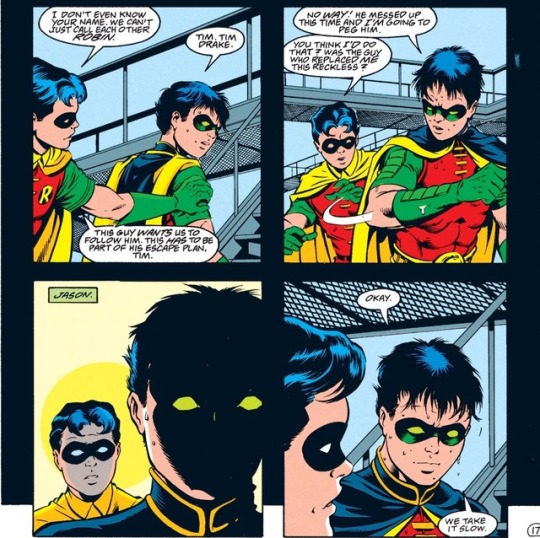
[Robin (1993) #10]
(I thought I remembered other similar mentions of Jason in Tim’s solo but I couldn’t find them. 183 issues man.)
Tim showed more respect to the memorial than to the person it was supposed to commemorate; he was introduced as worried that Robin would die permanently but not particularly touched that a child had died; he merely worried on the disastrous effect it’d have on Batman/Bruce. I think A Lonely Place of Dying made all of that pretty clear.
DC just couldn’t have Tim empathize with Jason, lest the readers themselves start empathizing with him too much which DC absolutely didn’t want. As a result Jason was used as a device to further prove Tim was dedicated and took Robin seriously (as if that wasn’t clear enough), and Tim came off as highly dismissive & disdainful of Jason on more than one occasion because it’s literally how DC wanted the reader to feel about Jason.
Tim was written in an era that constantly and viciously victim-blamed Jason. It impacted Tim’s portrayal and his view on Jason too. There are ways to exploit that— Tim was just a kid and never got to know Jason before his death, it’s not completely aberrant that he might’ve had misconceptions about him & I wouldn’t blame the character for it. But I blame DC a hell of a lot for framing Tim’s opinion as the absolute truth.
Tim idolizing Jason is a cute idea, really, and it’s a convenient place to get started if you want them to be pals in a fanfic. But as of post-crisis it’s completely fanon. It also pushes DC’s shittiness under the rug while they really don’t deserve their decades of ill-meaning and manipulative writing to be exonerated or simply forgotten.
And for all that I want Jason and Tim to get along (and Jason’s characterization is inconsistent enough that you can select the parts that’d make it work with Tim), I’m not a fan of how reboot went fanservice mode to make Tim & Jason best pals out of nowhere... especially at the cost of Tim’s and Dick’s dynamic.
Plus, how interesting would it be for Tim’s character growth to involve a change of mind about Jason? Tim’s usually pretty self-aware and knows to recognize his own inadequacies or faults. When the writer wants you to consider there’s no fault to speak of, though, it sure doesn’t help.
#jason todd#tim drake#batfam#meta#dick grayson#bruce wayne#dc comics#batman#nightwing#robin#red hood#batfamily#asks#zae chatters
778 notes
·
View notes
Text
‘Joker’ Paints An Uncomfortable Picture of Today’s World

Never did I think I’d see the day where I could parallel even the darkest of Batman themes to the world we live in.
Todd Phillips’ latest blockbuster Joker stars Joaquin Phoenix as the clown prince of crime we all know and love. Phillips’ other films include the Hangover trilogy, but this new film doesn’t have a happy go-lucky trio trying to remember their drunken stupors and find their fourth mate.
Joker makes the audience laugh, but in a nervous, sort of uncomfortable way.
At the Venice Film Festival, Joker received an eight-minute standing ovation.
Reviews poured in following the Italian premiere and they backed up the hype. Mark Hughes of Forbes said, “The fact is, everyone is going to be stunned by what Phoenix accomplishes, because it’s what many thought impossible — a portrayal that matches and potentially exceeds that of The Dark Knight’s Clown Prince of Crime.”
The film opens with Phoenix touching up his makeup in front of a vanity. He hooks his fingers in the corners of his mouth and pulls them upward in a smile, downwards in a frown, then back up again; a single, mascara-stained tears roll down his cheek, and laughter ensues.
Phoenix plays Arthur Fleck, an eccentric man with a funny laugh and a horrifying past, searching for his identity. The film encapsulates Arthur’s journey with himself and his downward spiral into becoming the Joker.
There are some prevalent themes within Joker that are worth talking about; the most prevalent being mental health and its effect on people in today’s society. There are several scenes in which Phoenix is sitting in front of his therapist, and she eventually jerks the needle off the record and informs him that the city has cut the clinic’s funding and their meetings must come to an end. The therapist goes on to claim that the higher-ups, “don’t give a shit,” about people like him or her.
According to the National Survey of Drug Use and Health, in 2016, 9.8 million adults aged 18 or older in the U.S. had a serious mental illness; 2.8 million of those adults were below the poverty line. Insurance companies have also been known to skimp when it comes to mental health cases, which makes it that much harder for people relating to Arthur to seek help. According to a study published by Milliman, in 2015, behavioral care was four to six times more likely to be provided out-of-network than medical or surgical care. In President Trump’s proposed 2020 budget, his administration aims to cut $241 billion from Medicaid, an assistance program that provides healthcare to low-income Americans.
Dancing is a symbol that is heavy in Joker. According to a Harvard study, “dance helps reduce stress, increases levels of the feel-good hormone serotonin, and helps develop new neural connections, especially in regions involved in executive function, long-term memory, and spatial recognition.” After especially tense scenes, Arthur begins a slow, emphasized dance routine that is hauntingly beautiful.

With mental health being such a prevalent theme, Arthur clinging onto dancing as a coping mechanism or escape from the world backs up the analysis that he’s doing it to improve his mental health — or at least attempt to.
In any Batman rendition — comics, movies, TV shows, video games — Gotham is always on fire… literally. In Joker, we see a bright Gotham in the beginning, with normal big-city crimes happening: teenagers stealing things, muggings, etc. By the end of the film, Arthur has bred chaos in the streets, and we see the imagery of Gotham that has become so prevalent within the Batman universe. In both Arthur and Gotham’s descent into madness, there’s an arc that’s ever present: protesting the elite.
All around the country, protests have emerged to combat the elite. Most recently, climate change has brought criticism on the world’s elite members and their inability to make a change. In the past, police brutality has created protests in riots from victim’s families and their supporters, calling for change in law enforcement procedures. Countless marches have been held in response to several pieces of legislations passed (abortion laws, Planned Parenthood budget cuts, LGBTQ+ rights).
“Kill The Rich” is a headline that pops up time and time again throughout the film, feeding into this “protest the elite” arc. Arthur guns down three rich men in the subway following their harassment of a woman and a physical altercation between himself and the men. This sparks a movement within Gotham that empowers Arthur and makes him feel noticed, something he’d never experienced in his life before. Citizens of Gotham supporting this movement don clown masks to imitate the suspect, aka, Arthur.
Joker has faced its fair share of backlash. Stephanie Zacharek of Time Magazine took no prisoners in her review, stating that Joker, “lionizes and glamorizes Arthur even as it shakes its head, faux-sorrowfully, over his violent behavior.” Other reviews have had similar opinions. In 2012, a mass shooting broke out at a Colorado movie theatre during The Dark Knight Rises premiere. The assailant fatally shot 12 people. Family members of the slain victims wrote a letter to Warner Bros. expressing their concerns.
Sandy Phillips, mother to 24-year-old victim Jessica Ghawi, told The Hollywood Reporter, “I don't need to see a picture of [the gunman]; I just need to see a Joker promo and I see a picture of the killer … My worry is that one person who may be out there — and who knows if it is just one — who is on the edge, who is wanting to be a mass shooter, may be encouraged by this movie. And that terrifies me.”
In what is perhaps its most iconic scene, Arthur eccentrically dances down the stairs that we see him trudge up throughout the film. This is also the first time we see him in that iconic purple suit, green hair, and a full face of makeup. He is dancing to Gary Glitter’s “Rock and Roll Part Two,” which has earned the film more backlash. Gary Glitter is a convicted pedophile currently serving a 16-year prison sentence. According to CNBC, Glitter is allegedly slated to receive royalties from the use of his song in the movie.
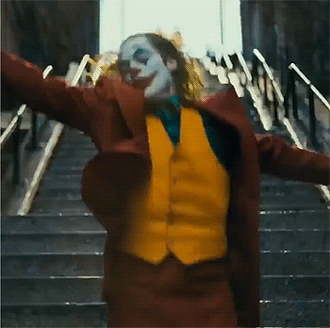
People took to Twitter to post their opinions about the film. One user tweeted, ���#JokerMovie was the most brutal, uncomfortable and tense movie experience I’ve had in a long time. Joaquin Phoenix is chilling. The film was spot on and did everything it should have for a character like the Joker.”
Another user tweeted, “Outstandingly Disturbing. Prolific. Necessary Blessing to Modern Cinema.”
As much as I enjoyed the film’s premise, production, and Phoenix’s performance, I do think there are some troubling themes that need to be brought up. Arthur often justifies his heinous actions by stating “they deserved it” and using the defense that society treats “people like him” like “trash” so, they should all die. He feeds into the “Kill The Rich” movement that he involuntarily created in the subway when he committed what we presume to be his first murder(s).
Though I know the concept behind the Joker character, I can see how this can be construed as glorifying gun violence. However, we can’t have the Gotham supervillain without violence and guns. It’s an accurate representation of the character, and it’s unfortunate that it parallels a lot of what’s going on in the world today.
The Joker is also painted to incite pity within viewers, which a lot of times, it does --- or at least attempts to. This is classic Joker behavior. In Paul Dini and Bruce Timm’s comic Mad Love, readers meet Dr. Harleen Quinzel, a psychiatrist at Arkham Asylum. She gets assigned to none other than --- you guessed it --- the Joker. Though this woman is highly educated (we won’t talk about the things she did to get that education), the Joker still manipulates her and convinces her to not only help him escape Arkham, but become his partner-in-crime as well; Harleen Quinzel is no more and Harley Quinn is born.
She pities him and his situation, and he spins his tale of woe so expertly that she has the wool pulled over her eyes. Throughout the comic --- and the general timeline for Joker and Harley --- Joker mercilessly abuses Harley, from pushing her out a window to not noticing she was gone for six months. He is a cruel, manipulative psychopath that nobody should follow in the footsteps of; however, he’s good at his job, and Joker showcases that, however controversial and uncomfortable it may be.
Joker is rated R for a reason; not only are there a few F-bombs, the violence is staggering. However, when dealing with a character that is known for inciting violence and not caring about the consequences, tough scenes are necessary. Phillips didn’t shy away from blood and intensity in his murder scenes, and Phoenix went all in when it came to brutality. Personally, (spoiler!) I never really wanted to see Robert De Niro’s brains blown out the back of his skull, but you can’t have the Joker without some blood.
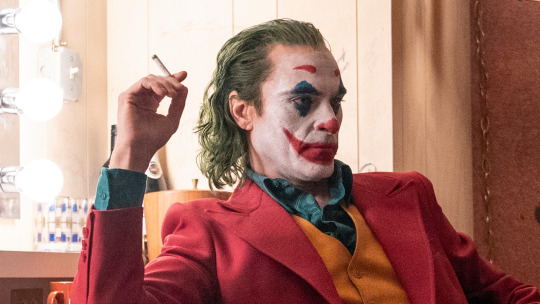
And finally, while the troubled citizens looking for a leader are terrorizing Gotham following Arthur’s murder of Murray Franklin (Robert De Niro) on live television, our hero’s story starts. Thomas and Martha Wayne are gunned down in an alley outside a theatre by a rogue thug and Joker fan, and young Bruce Wayne begins his famous story.
Joker was original in concept and plot, but had just enough callbacks to the comics to make it permissible. The atmosphere in the full theatre I was in was palpable. There were chuckles and titters here and there when Arthur would make a funny joke, or everyone was just laughing off the tension of the moment. There were also audible gasps and groans when things got especially rough (such as the aforementioned Robert De Niro scene). Joker did exactly what the real Joker would have wanted: it incited a reaction out of people.
I had low expectations going into the movie because, as someone who grew up reading Batman and loving to hate the Joker, I was afraid my favorite complex villain was going to get ruined (looking at you, Jared Leto). I was pleasantly surprised by Phoenix’s performance and Phillips’ take on Mista J, and it was a refreshing performance that was a polar opposite from the late Heath Ledger’s, but equally as convincing and chilling.
An Oscar seems to be on the horizon for both Phillips and Phoenix for Joker. The film is raunchy and tense, and I didn’t know I could hold my breath for two hours. It’s exactly what a Joker movie should be, and I’d encourage anyone to go watch it.
#joker#the joker#joker movie#review#joker review#comic book#comic book review#movie#dc#dc comics#todd phillips#joaquin phoenix#pop culture
1 note
·
View note
Text
Volume 4: Part 2
It’s been a while, but I finally got to sit down and write more about Berserk, specifically the second half of Volume 4. My posts are probably going to be more frequent now, so here goes nothing.

The material in volume 4 is probably one of the most common entry points for Western fans of Berserk. It’s the start of the Golden Age arc that most people are familiar with, throwing you for a loop that this is not like any other piece of Japanese media that you’ve read because it decidedly feels so European. The beginning of the Golden Age arc really reminds me of those Howard Pyle picture books that I grew up loving, like Men of Iron, showing the gritty and grueling practice of medieval combat, and also the elements of a revenge narrative that Berserk is just literally dripping with. It’s also patently obvious that many of Mirua’s influences are decidedly Western and medieval as well.
Guts’ challenge of and killing Bazuso is reminiscent of that swashbuckling, high-adventure vibe that’s so reminiscent of medieval depictions in the twentieth century that it’s not hard to see.
But I was reading the second half of Volume 4, something really stuck out for me. When Guts first confronts Griffith, I was surprised that he even made a passing comment on Griffith’s sexuality. “What are you some kind of homo?” when Griffith says “I want you, Guts,” and he’s really saying that he wants Guts to be his solider, but Guts can only hear the sexual nature of the phrase. Then, we have this moment that really shocked me.
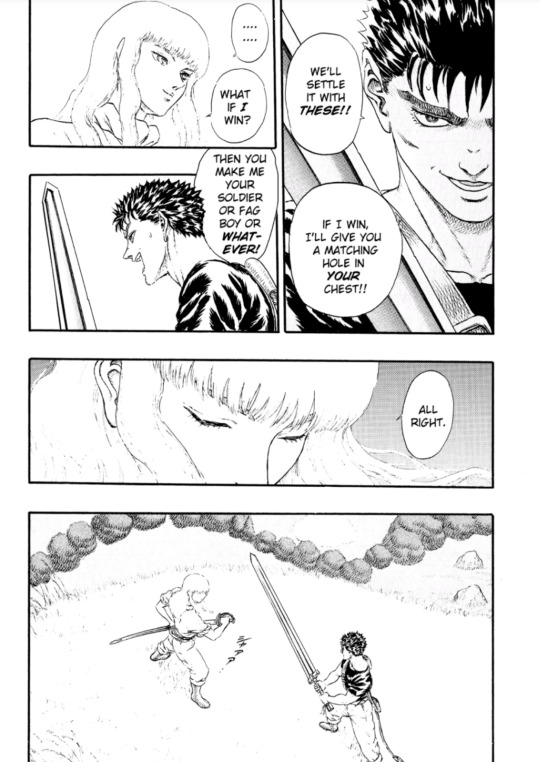
But maybe I shouldn’t have been so shocked that Guts uses the word “faggot.” Maybe it’s a translation error, maybe it isn’t. But I never heard him use the word in the dubs of its adaptations at all.
This scene where Guts and Griffith first meet and the following scene, where Griffith duels Guts and forcibly makes him a member of the Band of the Hawk have been recreated multiple times in adaptations, and this sexual innuendo is always left out or de-emphasized.
On one level, I shouldn’t be surprised that Guts would use the word “fag.” And given the sequence before, the dream sequence that Guts has about Gambino, Donovan, and his past sexual trauma and violation by Donovan and Gambino, it makes sense. Guts is a victim of abuse whose past is completely broken. The only thing that does make sense to him is fighting with his sword.
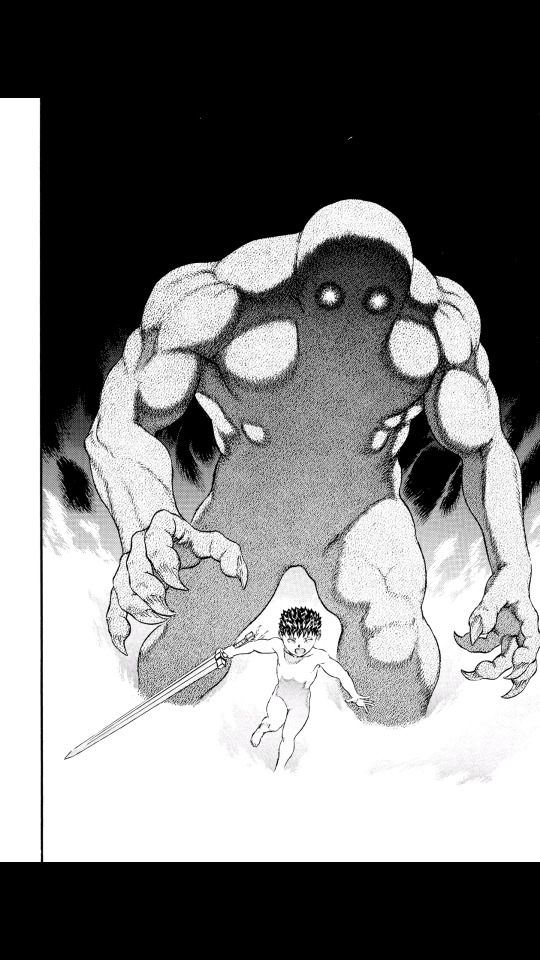
But of course, as the panel above depicts, Guts can’t solve his problems with his sword alone. In his dream sequence after his first fight with Griffith, Guts is running away from a monstrous Donovan, trying to fight him with his sword. He is a boy again, and about to be taken advantage of. So I guess the homophobia is understandable, given that he’s had to be incredibly callous and have all pretense of emotional intimacy stripped away from him violently at a young age, with all of the authority figures in his life betraying him.
What’s weird though is that the comments that Guts makes about Griffith’s sexuality get in the way of the intimacy that Griffith speaks of Guts’ style of fighting, that he never gives up, and would rather be putting himself in danger by fighting rather than living another day. And really, this seems to be what offends Guts more, but I can’t shake the fact that while it does make sense, the bigger story for Guts is that he doesn’t want anyone to control his life. He already has had to endure being hurt by people that were supposed to care and look out for him, and Gambino, the man who was supposed to be his surrogate father, sold him into sexual slavery. So it makes sense that Guts doesn’t want to be controlled by anyone, much less anyone who would threaten to use him sexually. That intimacy that Griffith shows to Guts, that charisma is strange and threatening to Guts. He isn’t interested in what people are going to tell him, he knows he’s good, But he’s also incredibly threatened that he’s being read like a book. And it’s that kind of intimacy that’s truly threatening to Guts. He doesn’t want anyone to have control of him.

But what’s surprising is Guts’ acceptance of Griffith’s fondness for him. Even after he’s beaten by Griffith, he’s worried that he won’t be able to best him again in combat. He keeps reliving the fight in his head, wondering what exactly went wrong. He simply can’t let it go, because Griffith has upended how he sees the world. He has never been wanted by anyone for his entire life, except to be used, and here is someone who sees him for what he is: a reckless warrior, and that terrifies him. It’s an interesting way to see these power dynamics in play, and encapsulates the two central questions that Berserk revolves around: What does it feel like to be powerful? And what does it feel like to be powerless?
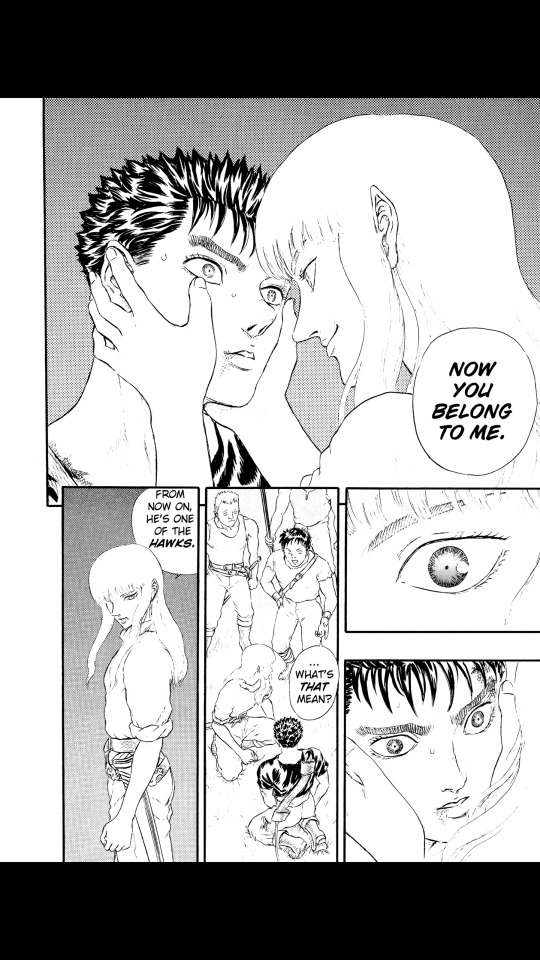
I still don’t know how this colors the dynamic that I see between the two. Sure it makes the subtext text, but honestly, that subtext is best left where it is, and I really think that the 1997 anime had it right when they didn’t even allude to any sexual tension between the two, because it was already subtextually there. Guts and Griffith are about as two halves of a whole like Kirk and Spock and other homosocial character pairings (not even ships, mind you, but just simple character pairings) create this intimacy between them that’s just dripping with a kind of tension that’s not entirely explicit but is really there between the lines.
Next time: Zodd the Immortal, fatalism, and more homosocial-ish stuff.
10 notes
·
View notes
Link
In early May, a group of 20 Black mothers in rural Mississippi logged onto a virtual group therapy session to discuss the immense, compounding pressures of providing for their families and caring for their children during a global pandemic and historic unemployment crisis. It was the first time any of them had talked to a traditional mental health counselor, and the results were cathartic.
“It’s important that we refuel — to be able to be better parents, to be able to be better daughters, to be better sisters and mothers,” says Dr. Erica Thompson, the executive director of Magnolia Medical Foundation, the community health nonprofit that ran the program.
Magnolia Medical Foundation’s pilot series was designed to address the unique challenges facing Black mothers in recent months as they navigate a pandemic that has disproportionately claimed Black lives, an unemployment crisis that has exposed the failures of the American social safety net, and the explosion of a national movement combatting the systemic violence perpetrated against Black people.
Magnolia Medical Foundation’s program invited mothers to participate in therapy sessions virtually, via computers or phones, and then stop at a drive-through to pick up information about mindfulness and coping mechanisms, as well as other more tangible resources, like food, cleaning supplies and face masks. “This allowed them to place those questions that they had, and to be able to pick up resources and information that they could carry with them to build out their recovery and their resilience and sustainability,” said Thompson, who returned to her native Mississippi after medical school to address the stark health disparities that faced Black people like herself.
But the Magnolia Medical Foundation is hardly alone in using this moment to find new ways to support Black mothers. In recent months, community leaders have rallied to offer Black women access to mental health care, counseling and information regarding their unique health challenges. Doula groups from Brooklyn to New Mexico have led online trainings on how to handle stress and trauma, and midwives in rural counties across the South taught clients how to take their own blood pressure and how to advocate for themselves in a hospital setting. Organizations like Black Mamas Matter Alliance and Black Women’s Health Imperative have published guidance and held webinars addressing topics targeted at Black moms, including navigating health insurance, accessing telehealth, and to how to give birth safely during the pandemic.
The focus on Black mothers is not incidental. Even before the pandemic, many Black women faced outsized barriers to health care. They are less likely as a group to be insured than their white counterparts, more likely to suffer from maternal health complications, and three to four times more likely to die from causes relating to pregnancy. Black mothers are also more likely to see their babies die, particularly in rural areas, where the mortality rate for infants born to Black women is at 11.8 deaths per 1,000 live births.
Enduring racism can also be a significant factor for Black women’s health, says Monica McLemore, a family health care nursing professor at the University of California, San Francisco. She and several colleagues recently published a study finding that Black mothers who reported high levels of racial discrimination may be at risk for preterm births and other negative birth outcomes. Other studies have shown that racism among medical practitioners affects the quality of care Black mothers receive, the amount of time doctors spend with Black patients, the way providers view Black patients’ pain and evaluate their complaints. Black mothers’ experiences with racism have also been associated with delays in seeking prenatal care.
Those stresses are perhaps compounded in the wake of George Floyd’s killing, when millions of people have shared violent videos on social media. “We are very worried and concerned about people’s exposure to repeated videos of the murders and shootings of unarmed black people,” McLemore says. “We also worry about the fact that many people who would have social support, currently don’t have that in the context of physical distancing.”
COVID-19 exacerbates negative health trends, in part because it fuels people’s fears of seeking out medical care, experts say. As hospitals reassign doctors and nurses to handle a surge in COVID-19 patients, other parts of the hospital — like maternity floors and family health wards — are understaffed and restricting outside visitors. “On-the-ground community based organizations have already been the safety net for so many of our communities, for folks who have historically not been able to access care,” says Dr. Jamila Perritt, an OB/GYN who works in community health centers in Washington, D.C. “So those networks are really critical in this time.”
Partly as a result of these factors, more Black women in recent months have expressed interest in giving birthing outside of hospitals, says Angela Doyinsola Aina, interim executive director of Black Mamas Matter Alliance, a group that brings together community organizations working on Black maternal health around the country. Laboring at home or in a birthing center can have upsides, research shows; home births can be associated with fewer interventions such as induced labor or cesarean sections. But they also carry significant risks, doctors warn, particularly for Black women who are more likely than their white counterparts to have serious, and potentially fatal, pregnancy complications such as fibroids and preeclampsia.
The apparent growing interest in giving birth outside of hospitals is a trend that worries many mainstream health care providers. In April, the American Academy of Pediatrics and the American College of Obstetricians and Gynecologists, which do not recommend home births, addressed the issue. The AAP published new guidance, while ACOG put out a statement on birth settings emphasizing the need for “patient-centered, respectful care” while reiterating that hospitals and accredited birth centers are the safest options.
Still, midwives say their services have been in high demand. Nikia Grayson, a certified nurse midwife at Choices, a reproductive health care center in Memphis, has been flooded with calls and social media messages every day for months. “Any means they can reach me they’re gonna do it,” she says. She is the only midwife in Memphis that can do both hospital and home births, and until recently, she was the primary provider at the center’s midwifery clinic and its wellness clinic for transgender patients. As a Black midwife operating in a city whose population is 64% Black, Grayson says she intentionally focused her practice on making sure families of color have safe birth options. Choices is set to open a birth center in August, which will be the first one in Memphis, and it has added three other midwives on staff so that it can ramp up its load from the 15 births per month it was handling in the first part of the pandemic to 30 births per month.
The large caseloads are not ideal for pregnant people or midwives, Grayson says. But they are a direct result of the restrictive way that midwives are regulated, particularly in the South. The midwives that do practice in the U.S. are often limited in where they can deliver babies and cannot always get their services reimbursed by private insurance or Medicaid.
Legislation related to the pandemic response may address some of these problems. In March, the Black Maternal Health Caucus in Congress introduced a package of legislation they called the “Black Maternal Health Momnibus Act,” and some ideas included there, such as allowing providers to offer telehealth services across state lines and extending Medicaid postpartum coverage, are inching forward.
But even as midwives, doulas and community health groups are seeing demand increase, many are struggling amid the ongoing economic crisis. Small health centers operate on shoestring budgets in the best of times, and an increase in total demand does not change the economic picture if patients can’t pay for the services. “A lot of these organizations are really trying to figure out if they’re going to stay in business,” says Linda Goler Blount, president and CEO of Black Women’s Health Imperative, which provides health information to women, advocates for policy change and funds federally qualified health centers. “We’ve seen organizations have to lay staff off, so even if they don’t close the doors, at what level will they be functioning in the next six months?”
Back in Mississippi, Dr. Thompson of the Magnolia Medical Foundation is working with Nakeitra Burse, a public health educator and consultant, to build a new program that will pair Black women in Jackson, Mississippi with doulas and create a registry of doulas in the state. The goal is to establish a more sustainable network of trusted, community providers who can address high maternal mortality rates and help Black women safely get the care they need.
“We have to do what we have to do for our community and not wait for someone else to do it,” Burse says. “We are still holding the system accountable. But until then, we have to create and do for ourselves at this moment.”
0 notes
Text
16
Devin Timpone: Short story idea (A synopsis)
Backstory:
Nuclear warfare has devastated most of the western world in a matter of only a few months. This left almost unlivable conditions for humanity in the following years. After the initial attacks wiped out almost two thirds of America’s population, those left faced the consequences of radiation. Some lost eye sight, others the ability to walk, but most inherited a cancer-type disease which damaged the skin and left them in poor immunity for the rest of their lives.
At this point, America faced the biggest depression of its existence. Civilization ceased to exist, religion was non existent, and people fought brutally over the lasting remains of food and water. Maybe believed it was the end. According to our narrator, this time was formally known as “The Dark.”
Years later, a religious group with new, exotic ideas gained popularity amongst anyone who was left. They offered hope, and a reevaluation of the values and morals people should hold. They preached the idea that the world fell because of a disconnect between humans and the earth. They believed humanity became too concerned with materialistic goods, ego, and technology, which in turn, destroyed the planet.
As this group gained power, people accepted them as a form of government and rule. They helped restore agriculture and vegetation. They truly did improve living conditions, and for a desperate world, they were a beacon of hope. They preached an ideal of nature over nurture really emphasizing that humans are born with the potential to do right, but only if they live undistracted by material goods and pleasure over the course of their lifetime. This began a new era known as “The Light”, or “The New World.”
There became a push for procreation, in order to restore the population size. Children born in this new world are known The Cardinal Generation. These children are special because they are the only ones to not have any radiation effects. They are healthy, strong, and in good health, and so the rest of society really depends on them to restore life to the way it used to be. Our narrator, twenty-two year old Finn, was a child of The Cardinal Generation. The New world is the only world he knows.
For the cardinal generation, fate is predetermined. At birth, babies are assigned to a “house” which is consistant with a sort of trade. Examples: healers, fighters, nurturers, etc. What house they are assigned to is dependent on uncontrollable, celestial circumstances such as the position of the moon when they are born. Their religion preaches that this is predetermined and chose by the universe. They can fall into one of ten houses, each consistent with a particular element— which determines what job they will have in the future. An example: our narrator was deemed ignisis, or, “of the fire” which makes him a good fighter. He has known since he was a little kid that he would fight in battle.
The new civilization is known as Luminor. Pleasures of today such as phones, magazines, pop culture, media, are banished, and considered black market goods. Our main character explains most people collect banished items from the black market. He had a wooden drum to play with as a child. It was his prize possession.
Most people live in rural areas, because big cities have turned into polluted, drug infested slums. People who do not follow the laws are often sent to cities to live the rest of their days. Cities are one of the only places you can find large amounts of goods from the old world. Most people who live in cities have severe, fatal forms of radiation poisoning and serve no use to the rest of society.
Plot:
The story opens up in Finn’s first person perspective, waking up in a hospital bed after having a strange, vivid, reoccurring dream. He is suffering a gruesome leg injury from a homemade bomb and has been unable to walk for weeks. It’s only now that he is gaining movement in it again.
He explains how there is tension between government rule and those who oppose it, those people being nicknamed “shuks.” Over the last few months, Luminor has seen a handful of ambushes from these rebels, and now Finn must recover quickly so he can be sent to fight back. He watches the nurses say a prayer for his sake.
We meet Finn’s best friend and the secondary character of the novel. He is known to almost everyone as “Spud.” Born Nathanial Isaac Dudley, Spud is one of five boys, each of which have died in battle. Finn feels great responsibility to keep Spud alive, for the sake of his single, grieving, mother. Spud is goofy, brash, and child-like. He isn’t the sharpest tool in the shed but has great courage and the ability to give his all to whatever cause he’s fighting for.
` Spud informs Finn that’s missed quite alot in the hospital. Since he was admitted, conditions in Luminor have turned violent again. Tensions between government rule and protestors have peaked. There has been a handful of ambushes from The Shuks in the last few days, an now they believe the Shuks are planning on ambushing Luminor again tonight. And since the hospital is in enemy territory, it’s vital that they move now and catch up with the other troops.
Spud supports Finn’s weight as they leave the hospital and move forward. Finn’s still losing alot of blood and goes in and out of consciousness.
It’s through these moments of unconsciousness that we learn more about Finn from his memories. He remembers “Transition” day, when he was sent away from his families at eighteen to begin his civic assignment as a solider. He remembers saying goodbye to his parents and how proud they were of him.
He also thinks Audra, his fiancè. In this society, each of the ten houses has another house that it goes with. The house you’re matched with is opposite you, and they’re stuck together to promote an idea of balance. You can only be married to someone who has the house sign of your designated match. Audra is a quiet, peaceful, girl. She’s assigned to the house Terrasis (nature and growth). At this point, we are unsure of the nature of Finn and Audra’s relationship, but he hints that they do not have much in common. Regardless, he cares about her deeply and sees a long future with her.
After walking around for some time, Spud and Finn have reached the gates of the city. The plan is to meet up with the rest of the troops who have stationed in an abandoned building. Instead, they are lost wandering down dangerous city states. Finn comments on the unfamiliar smells and accumulation of garbage and debris that lines the streets. He has never seen a city up close before. Before they realize, they are stopped by two Shuks of english decent. They smell like cigarettes and look intoxicated. Unable to fight back with Finn in such poor shape, Spud and Finn submit to being held at gunpoint by the men.
They are taken to an underground site of rebel Shuks where they are placed in a holding cell, mocked and ridiculed. Finn slips back into unconsciousness, where he dreams he is a drummer on stage in an alternate life, being cheered on by a crowd. When he wakes up, Spud is fighting off a drunken Shuk in an attempt to get away. In this chaos, a homemade bomb is dropped into the room they are being held. Spud jumps on the bomb to take the heat of the explosion. He is killed, and Finn’s life is spared. With his hearing impaired, Finn desperately looks around for a way out. Desperate and traumatized by his friend’s death, he limps through the underground tunnels until he comes across a familiar face.
The girl he encounters is one from a vague, but present memory of his childhood. She is a childhood friend of his, one who was assigned to the house of intellect, but instead left Luminor to join the rebellion. Finn remembers her name: Runa. They instantly recognize each other. Runa decides to help Finn, since she knows he will most likely die from his injuries in the near future. She helps him disguise himself as a Shuk and shows him around the underground tunnels of the city. Finn is amazed by the music, chaos, and parties of the city. It’s unlike anything he’s ever experienced. As much as it terrifies him, he is drawn to it. It’s like a secret that’s been kept from him this whole time.
Finn stays there for weeks and has an existential crisis— feeling guilty for leaving the rest of his troops to fight while he stays with the people he was raised to believe is the enemy. We see changes in his character as he embraces the philosophies of these people and begins to believe house system is impractical and a device to control the general public. He’s not sure what he believes at this point— and wonders who would be if he wasn’t assigned to be a soldier. A part of him wonders if he could be a musician, because of how much he loves the sound of drums.
The story comes to an end when the city is ambushed by Luminor. The last thing we know is Finn being faced with a choice to fight with the Shuks or the war boys. We don’t explicitly know the outcome of his choice, because his perspective once again goes into the unconscious state. He has a dream of an alternate reality where he lives without houses or rules, laws, or a fundamentalist upbringing. He begins to believe that the house he was assigned doesn’t define him, but the person he has become and the experiences he has gone through does instead.
In the final scene, weeks later, the number of rebels have almost tripled. They begin to walk into the streets of Luminor, protesting, chanting, in a mob of music, song, and banished clothing and jewelry. Though they know they could easily be shot and killed, they continue to walk, fearlessly, motivated by their cause. Finn is the back of the line, face painted, in real clothing, playing the drums to the beat of the music.
0 notes